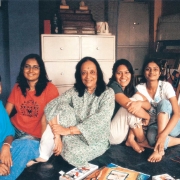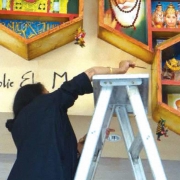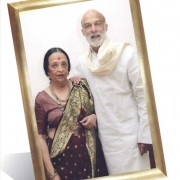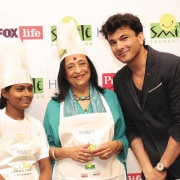
People
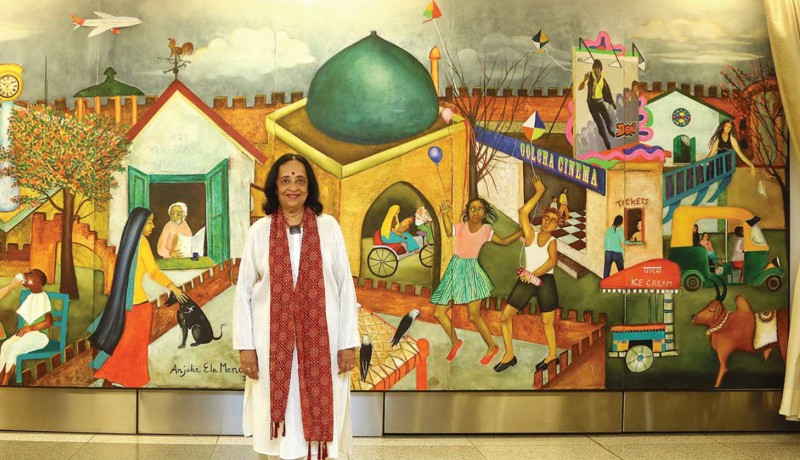
Walking down memory lane holds little interest for Anjolie Ela Menon. Busy and engaged with her art, the 76 year-old continues to see each day as a possibility for self-expression, each tomorrow as a new adventure, discovers Arati Rajan Menon.
Art is not linear; you go back and forth in time, you revisit things you’ve done a long time ago, you break new ground. You have to punctuate your journey with digressions.” It’s indeed been a remarkable journey for one of India’s finest and most successful contemporary artists, who has never shied away from pushing the envelope with her pioneering foray into computer-assisted art or her experiments with kitsch and painted objects. But Anjolie Ela Menon doesn’t indulge in flights of nostalgia—while others follow her trodden path, she moves on. On the heels of an installation for the Mumbai International Airport and acclaimed solo shows in Delhi and Mumbai last year, she’s just back from the Uttarayan Art Centre near Vadodara, where she enjoyed her first experience of creating sculpture. She’s going back soon. “I’m making a maze in Baroda,” she says, her expressive eyes afire. “The walls will, perhaps, have some graffiti; the dead ends will have pieces of art. I’m going to look for some young graffiti artists for the project.”
We are in the study in the jewel of a home she shares with her husband Raja, a strategic analyst who retired from the Indian Navy as an admiral, and her elder son, architect Rajaraja and his family. The books and maritime memorabilia around us are a distinct contrast to the whimsy and magic of the rest of the art-studded rooms, where Ninja the cat and Chloe the dog brush past each other with nonchalance. Elegant and stately in her trademark bindi and vibrant checked sari, she is quick to dispel any ‘lady of the manor’ stereotypes that may spring to mind—it is in her studio in nearby Nizamuddin basti, she assures you, that she is truly in her element. “Going to the studio every day is like riyaaz,” says the 76 year-old Padma Shri. “Nothing interrupts that.” She has tried, though. “After my last exhibition, I told myself I would be like a lady for a month—do lunch, go shop, catch a dinner and a movie…but after five days, I was so bored that I ran back to my filthy clothes and my studio!”
Excerpts from an interview
Last year, you held a solo exhibition in Mumbai featuring recent works after a gap of nine years; for Delhi, it was a gap of five. Have there been any creative changes or transitions in your work?
After a hiatus of a few years owing to an illness in the family that occupied me totally, and the execution of some large works for public spaces, 2015 saw a re-emergence of my oil on masonite paintings. So much so that I had two major exhibitions in one year: one in Delhi at Vadehra Art Gallery and one in Mumbai at Art Musings.
The Divine Mother series has captured the nuances and magic of motherhood. In fact, women and shakti are recurrent themes in your work. How do you see the status of Indian women today? Isn’t it ironic that on the one hand, women are breaking new ground, while on the other, they are still victims of sexism, regression and violence?
I have always engaged with the subject of parent and child and this led to the Divine Mother series—for all the Gods that are idolised there are the mothers who share in their divinity. I think it is wonderful material for an artist. I’ve done Parvati and Ganesh; Yashoda-Krishna, Jesus-Mary, etc. The place of the Divine Mother has always been important throughout history and it’s doubly important in the context of what’s happening today in India. There’s a dichotomy in the baffling events that have taken place in the recent past. On one hand we are the country that worships the Devi the most, whether it is Saraswati, Durga or Mary; yet look at the way women are being treated today. So there doesn’t seem to be a coherent connection between belief and practice; women are definitely treated as lesser beings. If the women of our myths find their rightful place, we further the interests of all women. But these paintings also show a connection to the past that have led to the present situation. For instance, in Parvati and Ganesh, Parvati has just experienced a terrible event—Shiva cutting the head of her baby. But her expression remains one of acceptance. This acceptance has dominated our discourse on gender for more than a thousand years. However we see that now; finally, we have begun to rebel against that.
Though you have said you are not particularly religious, you visit subjects of sacrifice and pilgrimage time and again. Why?
I have always been fascinated by the aesthetics and magnificence of religious art, whether it is early Christian art, the power of Islamic art, Buddhist art that pervaded the world for centuries and the monuments, sculpture and frescoes of Hindu traditions. I wept when the Bamiyan Buddhas were destroyed and that had nothing to do with my being religious! The collective devotion of millions is moving, as at the Kumbh Mela where crores of people worship in harmony.
You’ve mentioned your desire to transition from private paintings to public art. How has the experience proven? Tell us about some of your projects and the experience of executing them, such as your recent work for the Mumbai airport. Going forward, what are the larger benefits of a greater prevalence of public art?
So much of my work has virtually disappeared into private collections, never to be seen again, that I now aspire to do much more in the public domain if given the opportunity. It is the airports, hotels, corporations and train stations that are the purveyors of art today. Fifteen years ago, I did a mural in the Esplanade metro station in Kolkata; I’ve done murals in the LIC building, in hotels, at the T3 terminal in Delhi airport…. In fact, I’ve done a little installation at our own roundabout in Nizamuddin; I didn’t charge any money for it. I’m sure many of us artists would be happy to do projects like this. We have a long way to go in spreading awareness of art but art in a public space engages thousands more people, educating them by osmosis. Public art needs much more patronage.
For the Mumbai airport, I collaborated with a wonderful Australian photographer, Robyn Beeche. We did huge panels where the photographs look like paintings and the paintings look like photographs. We worked together for two years and finished the project. Sadly, soon after, we lost her to cancer. When we hung up the work, she wasn’t there to share it with me.
You’ve said that you’re not a ‘didactic artist’ and don’t do message art. Having said that, don’t you believe that any form of creativity has an inherent message? And further, do you believe artists can and should use their medium to shed light on many issues of concern?
No, not necessarily. In the making of didactic art, we must first ask who the message is aimed at and whether they are likely to be art viewers. The correct vehicle for conveying important messages is clearly TV and the electronic media, not art.
You were awarded by the Delhi Government a couple of years ago. Does the city still inspire you? In fact, in an interview with us in 2007, you stated, “Idyllic places like mountains paralyse me. I need the urban stimulus to work.” Are urban spaces still your muse?
Cities always inspire me. The city street continues to be full of source material. Of course, Delhi has evolved from a glorified village to being a real city. However, I have to admit it is Mumbai where art finds its moment. Modern Indian art is truly rooted there. Here we are but latter day ‘art immigrants’. I was very lucky to be a part of the Delhi that was. I went to university at Miranda House. In those days, we used to ride horses down Akbar Road and ride bicycles all over town. I was very lucky to grow up in Lutyen’s Delhi at 5 Motilal Nehru Marg with seven acres of garden around us. I feel we took that for granted at the time; we didn’t realise how privileged we were. But I’ve always been more of an urban creature. I also like to get away to Bangalore [where younger son Aditya, a software engineer, lives]. I need very much to be in the South; you know how Delhi can really get to you at times!
In 2007, you had also shared that your grandchildren Indeera and Madhavi [Rajaraja’s daughters] were starting to develop as artists. That was on the heels of your ‘family show’ Menon-ji-tis. Please tell us more about them today, and your other grandchildren and family.
Yes, Madhavi is now at NID – Ahmedabad studying design; Indeera is still making very cartoon-like miniatures; Avanti [Aditya’s daughter] is appearing for A levels with art as a major subject; and Rajaraja is continuing to ‘create iconic buildings’. Everyone in our house is drawing or painting all the time! Meanwhile, my grandson Vir [Aditya’s son] is a tabla player and an award-winning sailor!
We believe the faces of your own grandchildren and those of the dwellers of Nizamuddin basti, where you paint, find their way unbidden into your work….
I think it’s all very interactive. Yes, there are the faces that recur again and again in my paintings, those of my family and all my basti ‘grandchildren’ and close friends. However, I am distressed at what’s happening in the basti—so many of the young children I’ve seen grow up have grown up into young alcoholic men. We lost one of them recently.
Looking back, what, according to you, are the highlights or significant phases of your extensive career?
That’s an impossible question; so many events, landmarks, stumbling blocks, triumphs and disappointments, but I am still too busy to visit the past. I’m still flying; when I stop, I’ll land on my feet and perhaps I’ll have time to look back on the past. The rocking chair will probably come but it would be lovely to die with one’s boots on!
Do you work much with younger artists?
I like to meet younger artists. I’m part of a guru shishya parampara for SPIC MACAY [a voluntary youth organisation that promotes cultural heritage]. Once a year, students come to my studio and work with me for a month. It is quite rewarding. I also like to go to art camps sometimes and meet the younger lot of artists to see what they’re thinking, how they’re doing. The perception is that many of them are not as interested in technique as in ideology, in making a statement.
How has the Indian art scenario evolved over the years, both in terms of the market and the multiplicity of creative expression?
When I was a young painter, there were about 200 of us in India. Today, there are lakhs and lakhs. It’s a vibrant but often treacherous art scene for those who venture into this arena now. There are hundreds of dealers, galleries, genres, styles, ideologies and everyone seeking a place in the sun.
Today, do you feel creativity has taken a backseat to commercialisation?
It depends on the individual. Some people have gone into art thinking it’s a fast way to make money. I fear they will be in for a bit of a disappointment. You can only be an artist if you are driven to paint in spite of all odds. I have been in circumstances where it has been almost impossible to paint but I had to paint every day. It is as important to me as eating or sleeping. I’ve lived in places like Vladivostok at a time when there were no paints available; I’ve even had an exhibition there in 1968. That’s how motivated you have to be because art’s not a career, it’s a vocation. The very premise of art as a career is wrong.
Please share a typical day in your life. And a weekend!
I go to the studio in the mornings till 2.30 pm. I work on several paintings at a time because each layer takes time to dry. I use these very thin pigments and each layer has to dry before I can go on to the next. But I do go to the studio every day. One’s life is so full of events, children, grandchildren, and friends; but when I go to the studio, that’s my time, it’s absolutely my time. In the evenings, I stay at home to think about the next phase and to make maquettes and sketches for my future work. After lunch, I spend time with the grandchildren till 5 pm and then meet people who want conversations or interviews. Shop in a street market for produce and cook something nice for supper. Read in bed after supper or watch cricket if India is playing or a cooking show sometimes. Sleep late after making written lists for the next day. Weekends are always spent at our small place in Ghata village. I dress down, do some outdoor cooking, read the Sunday papers and do the crossword, come back home to eat momos for supper and sort out all the
farm produce we bring back.
You’ve said that if you weren’t a painter, you would be a chef. Tell us a little more about your passion for cooking.
I really love cooking and inventing different combinations. I often plan a sit-down dinner with several courses chosen from different parts of India and the world. I was thrilled to win a cooking contest recently! I’m sharing my recipe for a cold cucumber soup with you.
What’s your next destination?
Who knows? Perhaps New York is on the cards at the end of the year. But I really don’t know. It’s always a big question!
Has age affected your pace of work? Is it easier to find inspiration and stay motivated or harder?
Physically, it may be a bit harder but at 76, I am still climbing ladders and working on 20-ft-high scaffoldings. I am probably a bit wobbly but last year I worked 10 hours a day to finish two exhibitions and a large body of work for the new Mumbai airport, between swallowing pills and taking four injections of insulin daily! It’s all in the mind.
Today, many elders are revisiting their passion for painting—something they couldn’t pursue in their younger days. What is your message for them?
What a great idea! But it’s always hard to start. I advise novices to begin by painting an object—it could be a chair or an old cupboard or a tin trunk. That will get them started before they move to paper or canvas. A wonderful therapy for mind and spirit!
FROM MENON’S KITCHEN
Cold cucumber soup (serves 4)
Pressure-cook the following ingredients:
- 1 katori (cup) dhuli masoor dal
- 1 onion; chopped and fried till golden brown
- 2 cups water
- Half a cucumber
- 2 vegetable soup cubes (Maggi)
- Salt
Blend it with1½ cups of milk; grate the other half of the cucumber into the soup and chill. Garnish with coriander. Serve on ice cubes.
Pics courtesy: Anjolie Ela Menon Featured in Harmony — Celebrate Age Magazine March 2016
you may also like to read
-
For the love of Sanskrit
During her 60s, if you had told Sushila A that she would be securing a doctorate in Sanskrit in the….
-
Style sensation
Meet Instagram star Moon Lin Cocking a snook at ageism, this nonagenarian Taiwanese woman is slaying street fashion like….
-
Beauty and her beast
Meet Instagram star Linda Rodin Most beauty and style influencers on Instagram hope to launch their beauty line someday…..
-
Cooking up a storm!
Meet Instagram star Shanthi Ramachandran In today’s web-fuelled world, you can now get recipes for your favourite dishes at….



